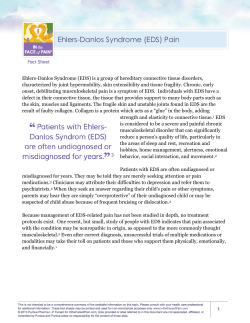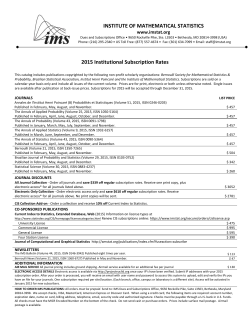
Bibliography - Enhancing Life Project
Blondheim, Menahem Partial Bibliography Alobiedat, A. (2012). Faculty and Student Perception Towards the Appropriate and Inappropriate Use of Mobile Phones in the Classroom at The University of Granada. International Journal of Instructional Media, 39(1). Barker, E. (2005). Crossing the boundary: New challenges to religious authority and control as a consequence of access to the Internet. In M. Hojsgaard & M. Warburg (Eds.), Religion and Cyberspace (pp. 67–85). London: Routledge. Barzilai-Nahon, K., & Barzilai, G. (2005). Cultured technology: Internet & religious fundamentalism. The Information Society, 21 (1), 25-40 Baumel, S.D. 2006, Sacred speakers: Language and culture among the Haredim in Israel. New York: Berghahn Books. Berelson, B. (1949). What "missing the newspaper" means. In P. F. Lazarsfeld & F. N. Stanton (Eds.), Communications Research, 1948-1949 (pp. 111-128). New York: Harper & Brothers. Blondheim, M. “The Significance of Communication According to Harold Adams Innis.” In Watson and Blondheim, eds., The Toronto School (2007), pp. 53-81. Blondheim, M. (forthcoming) “When Theology Met New Media: When theology met new media: ICTs as religious constructs, metaphors and generators. Blondheim, M. “The Jewish Communication Tradition and its Encounters with (the) New Media,” in: Heidi Campbell, ed., Digital Judaism (New York: Rutledge) Campbell, H. (2006a). Religion and the Internet. Communication Research Trends, 26(1), 3–24. Campbell, H. (2006b). Texting the faith: Religious users and cell phone culture. In A. Kavoori & N. Archeaux (Eds.), The cell phone reader. Essays in social transformation. (pp. 139-154). New York: Peter Lang. Campbell, H. A. (2010). Religious authority and the blogosphere. Journal of Computer‐ Mediated Communication, 15(2), 251-276. Campbell, S. W., & Kwak, N. (2011). Political involvement in “mobilized” society: The interactive relationships among mobile communication, network characteristics, and political participation. Journal of Communication, 61(6), 1005-1024. Carey, J. W. (1968). Harold Adams Innis and Marshall McLuhan. In R. Rosental (Eds.), McLuhan: Pro & con (pp. 270-308). New York: Funk & Wagnalls. Cohen, S. (1972). Folk devils and moral panics: The creation of mods and rockers. London: MacGibbon and Kee. Cohen, A., Lemish, D., Schejter, A.M. (2008). The Wonder Telephone in the Land of Miracles: Mobile Telephony in Israel. Cresskill, NJ: Hampton Press. Cromer, G. (1987). The polluted image: The response of ultra-orthodox Judaism to Israeli television. Sociology and Social Research, 71, 198–199. Cowan, D. (2005). Cyberhenge: Modern Pagans on the Internet. New York: Routledge. DiMaggio, P., Hargittai, E., Celeste, C., & Shafer, S. (2004). Digital inequality: From unequal access to differentiated use. Social inequality, 355-400. Drotner, K. (1992). Modernity and moral panic. In M. Skovmand (Ed.), Media cultures: Reappraising transnational media (pp. 42-62). London: Routledge. Fortunati, L. (2002). The Mobile Phone: Towards New Categories and Social Relations. Information. Communication and Society, 5, 513–528. 13 Blondheim, Menahem Ho, S.S., Lee, W. and Hameed, S.S. (2008). Muslim surfers on the internet: Using the theory of planned behavior to examine the factors influencing engagement in online religious activities. New Media and Society, 10(1): 93–113. Innis, H. (1950). Empire and Communications. Oxford: Clarendon Press. Innis, H. (1951). The Bias of Communication. Toronto: University of Toronto Press. Ito, M. (2005). Introduction: Personal, Portable, Pedestrian. In M. Ito, D. Okabe & M. Mastuda (Eds.), Personal, Portable, Pedestrian: Mobile Phones in Japanese Life (pp. 1-14). Cambridge: MIT Press Ito, M., Okabe, D. & Anderson, K. (2007). Portable objects in three global cities: The personalization of urban places. In R. Lind & S. Campbell (Eds.), The mobile communication research annual, Vol 1: The reconstruction of space and time through mobile communication practices. Transaction Books. Jenkins, H. (2006). Convergence Culture – Where Old and New Media Collide. New York: New York University Press. Katz, J. E. & Aakhus, M. (Eds.). (2002). Perpetual contact: Mobile communication, private talk, public performance. Cambrige, UK: Cambridge University Press. Katz, J.E. (2006). Magic in the Air: Mobile communication and the transformation of social life. New Brunswick, NJ: Transaction Publishers. Landau, S. Z., & Rabonovitz, Y. (1900). Or Layisharim [Light to the honest]. Warsaw, Poland: Halter.Levi, A 1989, The Ultra-Orthodox. Keter, Jerusalem. [In Hebrew] Livingstone, S. (1999). New media, new audiences?. New media and society, 1(1), 59-66. McLuhan, M. (1967) Understanding Media: The Extensions of man. London: Routledge and Kegan Paul. Neriya-Ben Shahar, R. & Lev-On, A. (2011). Gender, Religion, and New Media: Attitudes and Behaviors Related to the Internet Among Ultra-Orthodox Women Employed in Computerized Environments. International Journal of Communication 5, 875–895. Park, K. G., Han, S., & Kaid, L. L. (2013). Does social networking service usage mediate the association between smartphone usage and social capital?. New media & society, 15(7), 1077-1093. Prensky, M. (2013). Digital natives, digital immigrants. Cross Currents: Cultures, Communities, Technologies. Rheingold, H. (1999) ‘Look who’s talking’. Wired, 7(1). Online. Available at: http://www.wired.com/wired/archive/7.01/amish_pr.html (accessed 12 Aug. 2013). Ribak, R. (2006). Cultural reflections on the mobile phone in parent-teen relationships. In F. Sudweeks, H. Hrachovec and C. Ess (Eds.), Cultural Attitudes Towards Technology and Communication 2006, (pp. 595-605). Australia: Murdoch U. Press. Stadler, N. (2005) ‘Fundamentalism’, in N. de Lange & M. Freud-Kandel (Eds.), Modern Judaism: an Oxford Guide (pp. 216-227). Oxford and New York: Oxford University Press. Selwyn, N. (2003). Apart From Technology:Understanding People’s Non-Use of Information and Communication Technologies in Everyday Life.Technology in Society, 25(1), 99-116. Vries, I. (2005). “Mobile Telephony: Realising the Dream of Ideal Communication?”. In L. Hamill, & A. Lasen (Eds.), Mobile World: Past, Present, Future (pp. 9-28). London: Springer. 14
© Copyright 2025





















